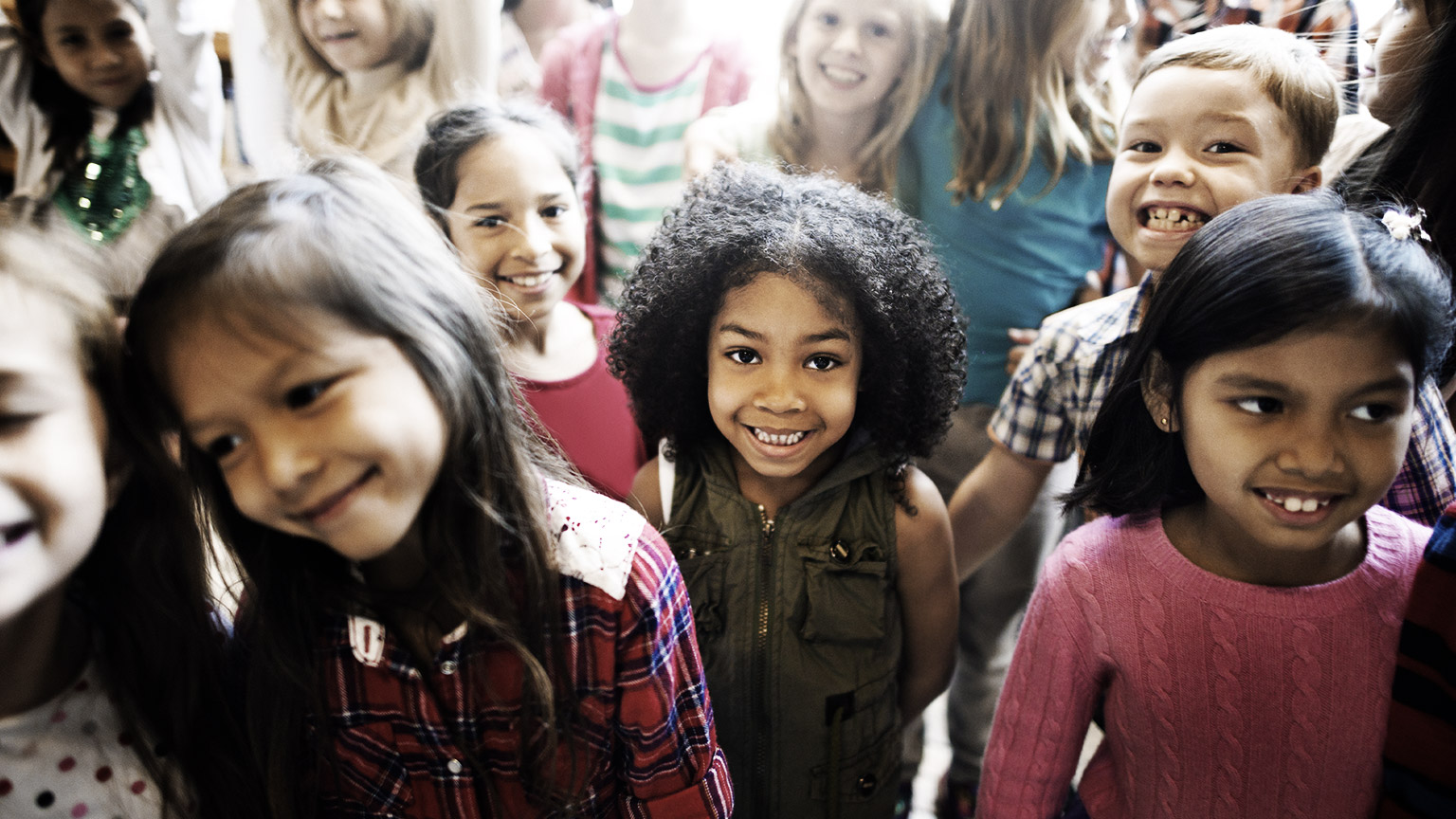In order for us to become inclusive, it is imperative to understand what this means, and begin to apply the thoughts and actions required to begin to incorporate diverse practices, policies and principles. Understanding other people’s lifestyles, experiences and perspectives helps to guide practices that support feelings of belonging and pave the way forward where all people are respected, represented and understood.
In this module you will gain an understanding of:
- Inclusion and inclusion principles
- Cultural safety
- Cultural Competency
- Cultural Capabilities
- Guidelines and requirements for inclusion, diversity and equity in early childhood services
- Ethical practices
In order for us to become inclusive, it is imperative to understand what this means, and begin to apply the thoughts and actions required to begin to incorporate diverse practices, policies and principles. Understanding other people’s lifestyles, experiences and perspectives helps to guide practices that support feelings of belonging and pave the way forward where all people are respected, represented and understood.
In this module you will gain an understanding of:
- Inclusion and inclusion principles
- Cultural safety
- Cultural Competency
- Cultural Capabilities
- Guidelines and requirements for inclusion, diversity and equity in early childhood services
- Ethical practices
EDUCATORS WHO EMBRACE AND WORK TOWARDS AN ONGOING KNOWLEDGE OF DIVERSITY LEAD THE WAY FOR CHILDREN, FAMILIES AND THE COMMUNITY, BUILDING A WORLD WHERE ALL PEOPLE ARE SEEN AS ONE, WHERE SIMILARITIES AND DIFFERENCES ARE ACKNOWLEDGED, RESPECTED AND REPRESENTED WITHIN THE SERVICE. EDUCATORS HELP TO SUPPORT THE NEXT GENERATION OF LEADERS TO THINK AND ACT INCLUSIVELY WITH RESPECT AND KNOWLEDGE. IN THIS CHAPTER, YOU WILL BEGIN TO UNDERSTAND TERMS AND ELEMENTS REQUIRED TO BEGIN THE JOURNEY TOWARDS INCLUSIVE PRACTICE WITHOUT TOKENISM.
What is Inclusion?
Watch this short video explaining the meaning of Inclusion.
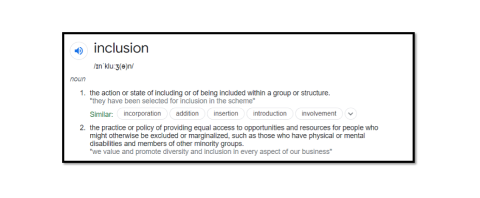
Inclusion is important for many reasons. It implements current thinking about child development; supports children’s rights; implements the legal standards for early childhood education and care; and is skilled professional practice. Inclusion fosters diversity and overcomes any barriers that might exist to ensure that every child experience quality early childhood education and care. Inclusion implements current thinking about child development. It reflects influential human development theory, particularly in early childhood. It recognises the positive and diverse influences on children’s development that provide a foundation for inclusion.
An ecological systems approach to childhood development states that cultural context—including socioeconomic status, poverty and ethnicity—affects a child’s experience, strengths and needs. Thus, effective education and care must recognise and be responsive within this context. Early learning without inclusion will be ineffective in meeting the different development needs of all children. Evidence shows that inclusive practice benefits all children in early learning.
Inclusion supports children’s rights. Every child should be valued as an individual and as a contributing member of their family, community and society. Consistent with the United Nations (UN) Convention on the Rights of the Child, inclusive practice in early childhood education and care ensures that every child has access to education ‘irrespective of ... race, colour, sex, language, religion, political or other opinion, national, ethnic or social origin, property, disability, birth or other statuses. Inclusive practices are also important to the fulfilment of other international conventions, including the UN Declaration on the Rights of Indigenous Peoples and the UN Convention on the Rights of Persons with Disabilities. Inclusion implements the legal standards for early childhood education and care. The legislation supporting the National Quality Framework is underpinned by principles of equity, inclusion and diversity. The National Quality Standard (NQS) specifies the facilitation of access to inclusion and support assistance, and each element places emphasis on the experience of each child. Inclusion is skilled professional practice.
How does Inclusion connect with Early Education?
The Council of Australian Governments’ (COAG) Investing in the Early Years—A National Early Childhood Development Strategy aims to ensure that ‘by 2020 all children have the best start in life to create a better future for themselves and for the nation’. Realising the COAG vision means ensuring that all, not just some, children benefit from social inclusion and reduced barriers to access.
The NQF (National Quality Framework) has 5 key components which are:
National Quality Standards
In relation to the National Quality Standards, Inclusion is connected to the following Quality Areas.
Quality Area 1 – Educational Program and Practice: This incorporates an approved learning framework (for example, the Early Years Learning Framework), planning for a child’s learning and development, evaluating documentation on a child’s learning, planning for plan, intentional teaching and educator reflection on practice.
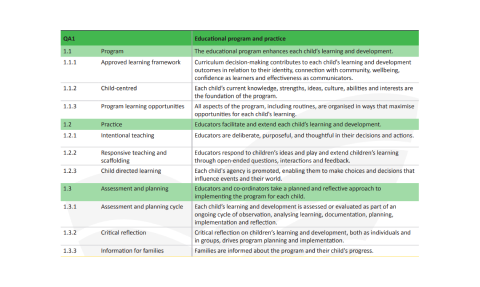
Quality Area 5 – Relationships with children: Developing respectful and supportive relationships with children and encouraging positive interactions with fellow peers. As well taking into account the dignity and rights of each child.

Quality Area 6 – Collaborative partnerships with families and communities: Developing respectful and supportive relationships with families and sharing information with families about community resources to support young children and their families.
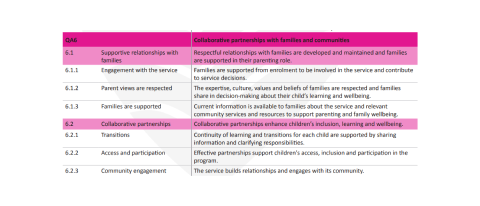
Approved Learning Frameworks
When looking at Inclusion in the approved learning frameworks the 5 principles they encompass is:
The five Principles that reflect contemporary theories and research evidence concerning children’s learning and early childhood pedagogy. The Principles underpin practice that is focused on assisting all children to make progress in relation to the Learning Outcomes.

Early Childhood Learning Programs
According to the Early Years Learning Framework cultural competence encompasses:
- Being aware of one’s own world view
- Developing positive attitudes towards cultural differences
- Gaining knowledge of different cultural practices and world views
- Developing skills for communication and interaction across cultures.
Educators must be willing to:
- Develop an eagerness to learn
- Aspire to meet cultural goals, objectives or targets
Educators should be able to:
- Take cultural knowledge on board
- Consolidate existing knowledge
- Put knowledge into supportive environments for learning to occur.
Under the EYLF, high-quality practice occurs when educators deliver an exciting and flexible learning environment that is responsive to the interests and abilities of all children. It also caters for different learning capacities and learning styles and invites children and families to participate actively in the planning and implementation of the curriculum. Inclusion means building upon and fostering diversity. It involves working with every child and not particular groups of children. Each child’s strengths are built upon, and any barriers to learning facing a child are recognised and responded to. Inclusion seeks to address circumstances where some children may be excluded, under-represented, or are unable to access early childhood education and care.
The 4 key elements of inclusion
What is Diversity?
What does Diversity mean to you? Before we deep dive into what it means, watch this short video below explaining the concept of Diversity.
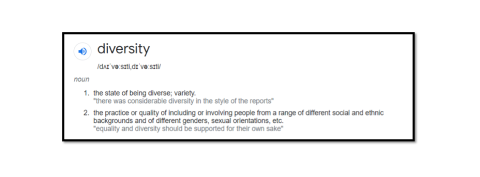
Google Dictionary Meaning
Respect for diversity and working for equity is highlighted in the Australian Early Years Learning Framework (EYLF) and the My Time, Our Place as key principles underpinning early and middle childhood educational practice. Both learning frameworks note that ‘respecting diversity means within the curriculum valuing and reflecting the practices, values and beliefs of families’. The frameworks also state that educators ‘who are committed to equity believe in all children’s capacities to succeed, regardless of diverse circumstances and abilities’ (2009, p.13; 2011, p.11). This fact sheet will explore diversity and equity, highlighting the differences between the two. Questions are included to promote reflection and discussion. Respect for diversity and working for equity are critical aspects of the work educators do every day to create a more socially just community for all.
Check out this next video explaining cultural diversity and how you can celebrate your friends from different cultural backgrounds.
Embedded in the National Quality Standard Quality Area 1, child centred programs are the core or the foundation of every ECEC service. Honouring cultural diversity involves collaboration between children, families, and teachers as well as those beyond EC services.
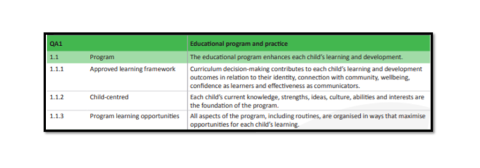

Social justice is fundamental to the principles of inclusion. It emphasizes the need to create environments where all children, including Aboriginal and Torres Strait Islander children, are welcomed and valued. For social justice to become a reality, four (4) pillars must be built:
- Human rights: When a society is just, it protects and respects everyone’s human rights.
- Access: A just society depends on access to essentials like shelter, food, medical care, and education.
- Participation: Participation must be promoted, encouraged, and rewarded so everyone – especially those who haven’t had a chance to participate before – can speak.
- Equity: Equity, not equality, is the principle that truly embodies social justice, as it considers the different circumstances and barriers individuals face. By aiming for equitable outcomes, society can provide the necessary resources and support to ensure that everyone has the same opportunity to succeed.
Services that set the tone for the principles of equity, inclusion and diversity consider the fundamental differences between each child, demonstrating the celebration of each child as a unique individual. These differences could include the child's needs, background, life experiences, gender, history, development, culture and abilities.
The journey towards inclusion and cultural competence is demonstrated when services implement thoughts into action and include consideration towards others. This is visible through their policies, procedures and protocols that promote equal access and opportunity for all children and their families. The main principle informs us that all children, regardless of their ability, socioeconomic status or cultural background, may access and participate in the service in the same way as other children.
INCLUSION IS NOT STATIC, BUT DYNAMIC
In building on fostering diversity, pedagogical principles promote
- Respecting the rights of each child
- Respecting the rights of each child’s family
- The importance of having high expectations of each child
Early Childhood Australia (2014), supports three key dimensions required for inclusion into early childhood services. These are:
Access
Inclusion means ensuring that every child has access to early learning. Inclusive access requires early learning services to be set up and organised around a diverse community. Systemic, service and individual barriers must be overcome to enable inclusive access.
Participation
Inclusion requires meaningful participation. Inclusive early childhood education and care provides programs in which children are recognised as active agents in their own learning. Meaningful participation is grounded in the overarching concepts of Early Years Learning Framework (EYLF): Belonging, Being and Becoming.
Outcomes
Inclusive early childhood education and care means that every child experiences positive learning outcomes in the areas identified in the EYLF namely that they:
- Have a strong sense of identity
- Are connected with and contribute to their world
- Have a strong sense of wellbeing
- Are confident and involved learners
- Are effective communicators

Assimilation
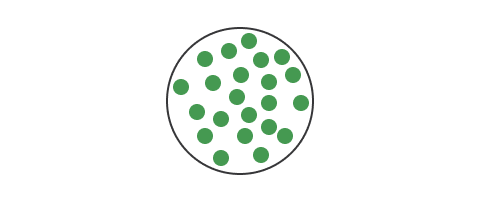
Assimilation is the act of being absorbed, understanding, or taking in, the ideas, language, culture and way of 'being' of another and adopting this in practice. However, this usually favours the dominant group's culture and practice, not the minority. As is evident in the image above, the minority disappears along with their values, culture, language and own lifestyle so as to integrate into the society of the majority group.
Next watch this video by the Healing Foundation titled “Telling our stories”.
Exclusion
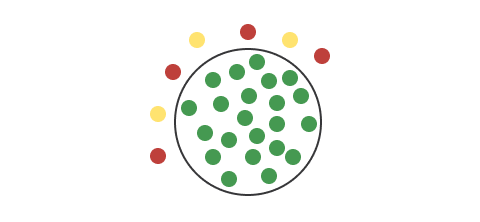
As a reversal to inclusion, exclusion demonstrates a society that has separated a group, body or person from the networks, connections, access, opportunities and assistance that remains available to the majority body.
As shown in the image above, this places them on the 'outside' of society or the group.
In the next video we are going to have a look at the concept of social exclusion.
This next video is a Ted Talk by Ronna Timpa talking about the concept of 'Exclusion is an Invisible Disease'.
This next video is a social experiment that was conducted on children to understand and explain the effect of racism on children.
Segregation
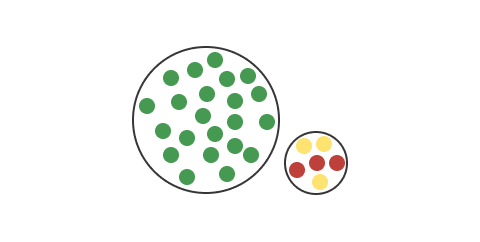
Segregation is the process of separating those who are typically in the minority group, from those who are in the majority group. Segregation minimises the chances of successful inclusion and amalgamation of populations and can also, similarly to exclusion, minimise access to quality programs and opportunity.
This next video is a video about children explaining the concept of segregation and what it means to them.
Integration
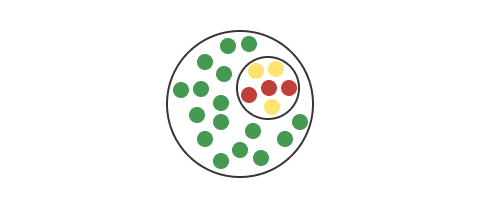
This is the process of incorporating minority groups or new people or groups into the social structure of society as an inclusionary goal.
The difference between integration and assimilation is apparent through the availability, access and assistance of social supports that structure the three pillars below:
- Social integration (social engagement, activities and relationships)
- Economic integration
- Identity integration (commonality and self and cultural concept - for example, social roles)
- Quality assurance in the service monitors for elements such as unwanted uniformity and choice of minority groups.
Integration differs from assimilation because it includes three inclusion dimensions
- Social Integration
- Economic Integration
- Identify Integration
Supporting Inclusion

Children who may require or will benefit from additional support, service or adaptations to participate in early years services may include:
- Children with disability or developmental delay
- Children experiencing physical, medical or mental health conditions
- Aboriginal children
- Torres Strait Islander children
- Children from culturally and linguistically diverse backgrounds
- Refugees
- Gender-diverse or gender-fluid children
- Children from lesbian, gay, bisexual, transgender or intersex (LGBTIQ) families
- Children with complex social, emotional or behavioural needs
- Gifted children
- Children experiencing social, economic or geographic disadvantage
- Children at risk of abuse, neglect or family violence
Diversity Awareness

Diversity are the differences and varieties that occur between people, and although no one person is the same as another, typically, the act of diversity is the inclusion of people from a range of differing backgrounds and life experiences such as different social and ethnic backgrounds, cultures, abilities, genders, sexual orientation, or lifestyle.
In establishing a genuinely valued diverse environment, actions need to occur at the business end if a service or organization, where the attitudes toward positive inclusion of diversity stems from policies surrounded by equity and access for all. Considerations need to be made for this so that the effort does not become tokenistic of a law that is mandated to a service, but by the desire to assist in developing an inclusive society where diversity is cherished and understood as a civil and human right worth its weight in gold. When self awareness is embraced, the uniqueness of all individuals is recognized with an aim to unstand the customs, cultures, religions, socioeconomic natures and abilities. This is observed widely through the service, from its philosophies, policies, procedures, through its curriculums, daily routines and interactions.
Next, watch this Ted Talk by Chimamanda Ngozi talking about 'The danger of a single story'.
Take a moment

Have a breather and take a moment to reflect on the videos we just watched. Look at the questions below and reflect on the videos and their content and how they make you feel.
Question 1: Did their stories surprise you at all?
Question 2: How did their diverse stories and perspectives honor their own reflections and learnings about diversity?
CULTURALLY COMPETENT INDIVIDUALS ARE LIKELY TO HAVE, AMONG OTHER THINGS, A STRONG KNOWLEDGE OF HOW THEIR OWN CULTURE SHAPES THEIR ATTITUDES, PERCEPTIONS AND BEHAVIORS AND AN AWARENESS OF THE LIMITED VALUE OF STEREOTYPING.Department of Education, Employment and Workplace Relations (DEEWR) for the Council of Australian Government (2010)
Inclusion for culturally and linguistically diverse children
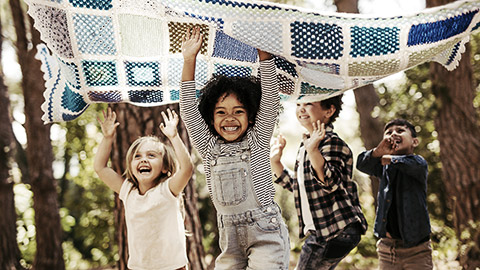
The phrase 'culturally and linguistically diverse' is a broad term used to describe communities with diverse languages, ethnic backgrounds, nationalities, traditions, societal structures, and religions.
Connections are an important means to create a sense of belonging and enable the inclusion of culturally and linguistically diverse children. In most of the early childhood education and care services find that food and celebrations connect families, children, and the community. They celebrate many cultural events including, but not limited to, Diwali, Chinese New Year, St. Patricks Day, Aboriginal Day, harmony day, and NAIDOC week. This gives a sense of belonging. Services use group times and other intentional teaching opportunities to instruct children about similarities and differences. Parental and wider community involvement leads to children sharing cultural foods and traditional costumes, engaging in photo shoots, and connecting and learning about each other’s cultures. Cooks in the Early Childhood services caters to a wide variety of dietary needs with a diverse menu to meet the nutritional and religious guidelines of children, including vegetarian and halal options. Some menu choices are butter chicken or chickpeas with saffron rice, truffle mac and cheese, and margarita pizza with bocconcini and basil.
On enrolment, families usually inform if their child cannot speak much English as they speak their mother tongue at home. Educators use a range of methods to communicate messages and help develop relationships with children and families in the Early childhood education and care services. Service providers ensure that their team has diverse educators who speak many of the languages of families and can help interpret the needs of the family, their culture, and their children. Services bridge the language barrier by utilising their bilingual educators to assist in their orientation process and in supporting children when they are having difficulty with the dramatic change in culture they experience when they first attend our education and care service.
The reciprocal relationships can be supported by each other to provide best outcomes for all. Services must provide a multifunction prayer room to help their educators and families with a discreet place where they can practice their spirituality. Educators must build strong connections and have strengths that they nurture and share with their families in ways to extend learning and connection. Through relationships, services strive to create a transformational place of learning, connection, and inclusive practice. Everything that the Early childhood education and car services do from the time the parents join the waitlist and come in for a tour of the service, to the time children transition and graduate from one room to the next is individual and focused on the needs of that child and family. ‘Culture is the fundamental building block of identity, and the development of a strong cultural identity is essential to children’s healthy sense of who they are and where they belong’ (DEEWR, 2010, p. 21)
The Code of Ethics sets aside guidelines for those working with children and families in early childhood education settings, recognising that ‘Aboriginal and Torres Strait Islander people have been nurturing and teaching children on this land for thousands of years… [and the] traditional ways of being and caring for children’ (Early Childhood Australia (ECA) 2019). The Code of Ethics is a framework for professional reflection, decision making, and ethical responsibilities based on principles in the United Nations Convention on the Rights of the Child (1991) and the Declaration on the Rights of Indigenous Peoples (2007).
Children with Additional Rights
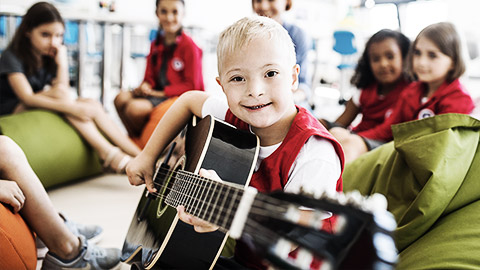
Choosing a service can be hard for every parent, but it can be even more overwhelming for parents who have a child with additional needs. Some feel stressed about how their child will ‘fit in’ to a mainstream environment, and others may worry about how well their child’s specific needs will be met.
If your child has additional needs, they may benefit greatly from attending a quality service. It will provide your child with opportunities that will support and enhance their learning, skills, experiences and development.
It can also benefit your family, providing peace of mind knowing that your child is in good hands.
What should your education and care service do?
- Work collaboratively with you about your child’s specific needs including your child’s social, emotional and physical development and how these can be supported
- Respect and accept your child
- Show that they see your child as a whole person, not only in terms of their needs
- Take the time to get to know your child, their strengths and interests, as well as their areas of need
- Use your child’s interests and strengths as a basis for planning activities
- Adapt planned activities and daily routines to support your child’s participation, where possible
- In a sensitive way, help other children and adults to understand your child’s needs and include your child in daily activities
- Acknowledge and uphold your family’s and children’s rights to confidentiality
- Provide you with regular information about your child’s progress and experiences, as well as any concerns or issues that arise
- Record daily information about your child e.g. details relating to toileting, eating habits, and their behaviour with other children etc.
There are many things you can share with the educators at your service to help your child’s inclusion
- What your child’s main needs are and how these affect their daily lives and experiences
- Their interests and the things that they do well
- The strategies you use to support your child at home and elsewhere e.g. ways to calm or distract your child when they are upset
- The situations or routines that can cause physical or emotional challenges for your child
- The signs to look out for to see if your child is distressed or is having difficulty coping
- Details about the support or other therapies your child is receiving and encourage contact between these services
Many services will obtain information about your child and their additional rights prior to commencing at the service. Usually, the Service Director/ Manager will work with the family to obtain the necessary documentation, and service forms that may need to be filled out and inform the staff of the child, their needs, and their family needs from the educators and devise a plan of attack.
The Inclusion Support Program

The Inclusion Support Program (ISP) assists education and care services to include children with additional needs alongside their peers. e Inclusion Support Program (ISP) assists education and care services to include children with additional needs alongside their peers.
The Inclusion Support Program (ISP) assists education and care services to provide and embed quality inclusive practices into their delivery of early learning programs for all children, to address access and participation barriers and to support the inclusion of children with additional needs, with their typically developing peers.
Seven Inclusion Agencies across eight states and territories are available to work with services to provide a quality inclusive environment for children with additional needs. Inclusion Agencies have an established network of Inclusion Professionals to provide practical and tailored advice and support to services on effective inclusive practice, including techniques for improvement and solutions to address particular barriers.
Read more about the Inclusion Support Program.
Disability and Inclusion Program- NSW Government
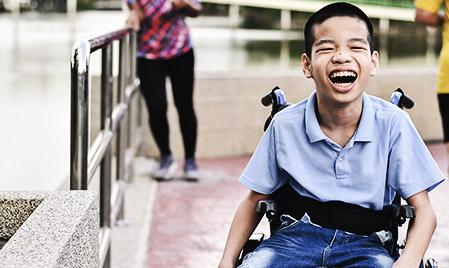
The Disability and Inclusion Program provides funding and support to enable children with disability and additional needs in community preschools to participate in a quality early childhood education program on the same basis as their peers.
Research and data show:
- in NSW, the proportion of all children enrolled in a preschool program aged 3 – 5 years with a disability is 7.6%.[1]External link
- about 85 per cent of community preschool educators work with a child with disability.[2]External link
- children who participate in a quality early childhood education program for at least 600 hours in the year before school are more likely to arrive at school equipped with the social, cognitive and emotional skills they need to engage in learning.
- that most children with disability will benefit from inclusive early childhood education, including greater engagement with peers and positive effects on play and behaviour. [3]External link
This program is consistent with:
- the NSW Government’s National Partnership Agreement on Universal Access to Early Childhood Education with the Commonwealth Government.
- the provisions of the Children (Education and Care Services National Law Application) Act 2010 and regulations under that law
- the Disability Discrimination Act 1992
- the Disability Standards for Education 2005
- the National Disability Insurance Scheme (NDIS)
- NSW Department of Education and Training Disability Criteria 2003
The Disability and Inclusion Program is complemented by Start Strong funding for community preschools.
Under Start Strong, preschools are required to provide priority of access to a quality preschool program to children with disability and additional needs. Start Strong equity funding is also available for children with disability and additional needs.
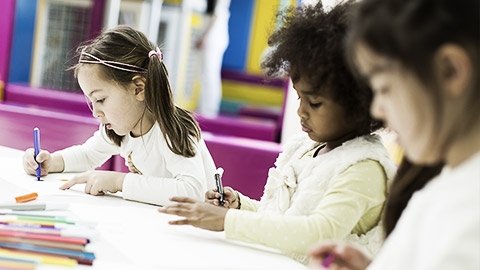
Before you reflect on your own cultural heritage, you need to understand what the term ‘culture’ means. For many, culture is about the country they are from, the language
they speak and their physical features, such as or the colour of their skin. However, culture includes much more than this. It is influenced by the set of beliefs, values and traditions that have been instilled since birth through socialisation, and is influenced by family and the wider society.
Culture

Culture involves rituals, practices, stories, customs, beliefs and values. It includes how we live our lives, what we believe in and the values we hold dear. It influences goals in life and beliefs about others, and may change slowly over time through experiences that formulate views and understandings. You may not realise your own culture until you are removed from it. This may occur when you are exposed to new experiences or new people who live in different ways to you. Examining your own culture and how it has developed will help you to understand how the culture of others has evolved, and how important beliefs and values change to form new ways of viewing the world. To become a culturally competent educator, it is important to respect and celebrate diversity.
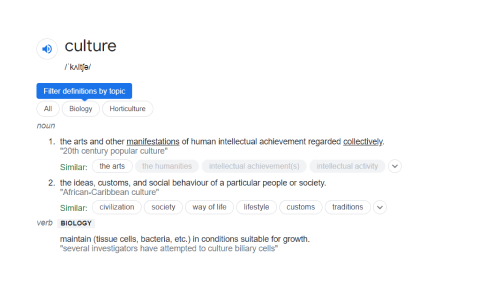
Children who may require or benefit from additional supports or adaptations to participate fully and be included in early years services are:
- children with disability or developmental delay
- children experiencing physical, medical, or mental health conditions.
- Aboriginal children ¡ Torres Strait Islander children.
- children from culturally and linguistically diverse backgrounds
- refugees
- gender-diverse or gender-fluid children, and children from lesbian, gay, bisexual, transgender or intersex (LGBTI) families.
- children with complex social, emotional, or behavioural needs children who are gifted.
- children experiencing social, economic, or geographic disadvantage children at risk of abuse, neglect, or family violence
- children in institutional settings, including residential care, refuges, hospitals, or migration detention.
Inclusive practice ensures that the diversity of children is reflected in early childhood education and care settings. ECA’s factsheet, the experience of inclusion and exclusion in early childhood education and care, outlines the nature and experience of exclusion and lists some resources that may support services to overcome it.
Aboriginal Cultural Capability
Cultural capacity is a joint effort between building cultural competency, awareness and cultural safety that is an evolving, dynamic self-model addressing the learning that occurs over time.
Cultural competence comes from Latin competere, loosely translating as a sense of many differences that "come together" and surrounds itself in the behaviours, attitudes, and policies that may enable an individual or group to work effectively in cross-cultural situations (Consolata, 2018). The cultural competence is based on the actions of individuals and systems that respond respectfully, efficiently, and effectively to people of different cultures and strengthen their sense of worth. To achieve diversity, the goal of a culturally competent society is to ensure cultural pluralism, which is the maintenance of the unique cultural identities and values of the groups within the community and is amalgamated into the laws and values of the wider society where self efficacy is embedded.
Learning Journey of Cultural Competence
A journey, not an end point
The Secretariat of National Aboriginal and Islander Child Care (SNAICC) informs that to be culturally proficient, [citizens need to understand that it] “requires more than becoming culturally aware or practising tolerance” and involves “identifying and challenging one’s own cultural assumptions, values and beliefs, and making a commitment to communicating at the cultural interfaceSNAICC, 2012
Steps towards cultural competency may include:
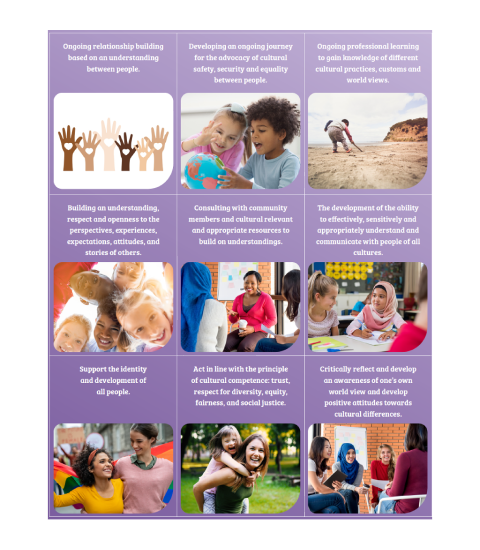
The cultural competence continuum demonstrates the journey of learning ovr time and draws from the Victorian Aboriginal Child Care Agency (VACCA) from their work of the Aboriginal Cultural Competency Framework and speech made by Muriel Bamblett’s at SNAICC 2007.
It stems from previous work by Terry Cross of the National Indian Child Welfare Association (US). The image below displays the stages of cultural competency, explaining the importance of continued learning and reflection as an ongoing process to aim to eventually reach proficiency.
| Characterised by: | ||
|---|---|---|
| Cultural Destructiveness | Intentional attitudes, policies and practices are destructive to cultures and consequently to individuals within the culture. | |
| Cultural Incapacity | Lack of capacity to help minority clients or communities due to extremely biased beliefs and a paternal attitude towards those not of mainstream culture. | |
| Cultural Blindness | The belief that service or helping approach is traditionally used by the dominant culture and are universally applicable regardless of race or culture. These services ignore cultural strengths and encourage assimilation. | |
| Cultural Pre-competence | Towards Cultural competence |
The desire to deliver quality services and a commitment to diversity indicated by hiring minority staff, initiating training and recruiting minority members for agency leadership, but lacking information on how to maximize these capacities. This level of competence can lead to tokenism. |
| Cultural Competence |
Acceptance and respect for different continuing self-assessment, careful attention to the dynamics of difference, continuous expansion of knowledge and resources, and adaptation of services to better meet the needs of diverse populations. |
|
| Cultural Profieciency |
Holding culture in high esteem; seeking to add to the knowledge base of culturally competent practice by conducting research, influencing approaches to care, and improving relations between cultures. It also promotes self-determination. |
The EYLF supports cultural competence through Principle of Respect for diversity and the practice of cultural competency, where they remind educators that 'there are many ways of living, being and of knowing' (ACECQA, 2018 pg. 14, 18-19).
The EYLF continues to inform that 'the culture that children are born into is a place of belonging and is influenced by ancient and traditional practices,experiences, value and beliefs. Respecting this within a service means building a curriculum, policies and practices that honour the abilities, strengths, heritage, ancestral knowledge, histories, cultures, languages, traditions, child-rearing practices, complexities and lifestyle choices of the families. Culturally competent educators acknowledge that with inclusive diversitycomes a richness to our society and respect for multiple cultural ways of knowing, seeing and living. They celebrate the benefits of diversity and have an ability to understand and honour differences' (ACECQA, 2018: pp.14, 18-19).
The Victorian Early Years Learning and Development Framework (VEYLDF) incorporates indigenous elements further stating that, 'learning about and valuing the place of Aboriginal people will enhance all Victorian children's sense of place in our community' (DEECD, 2011: pp 4).
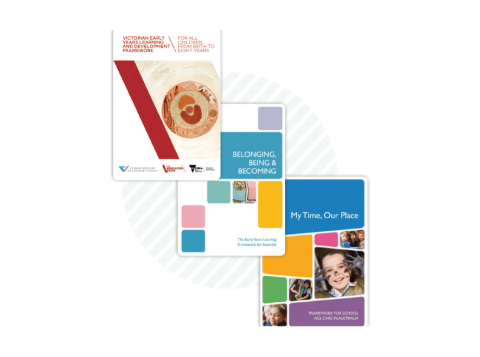
Cultural safety is an environment that is safe from assault, challenge or denial of a person's identity and experience. Cultural safety is impacted by the actions, attitudes, values and systems in place by individuals and organisations. Cultural safety means that these individuals and organisations are aware of their impact on people from other cultures including Aboriginal and Torres Strait Islander people and work to build an environment where all people are treated in a culturally respectful way. Service can support cultural safety by:
| Implementing the acknowledgement of country within formal meetings, events and introducing it to children and introducing it to children within daily routines | Acknowledging the traditional owns of the land with signage at the service | Consult with local members to ensure genuine and accurate information, customs and guidelines are being utilized |
| Display Aboriginal and Torres Strait Islander flags, artwork and genuine examples of customs within the service and curriculum, whilst maintaining indigenous artists copyright and intellectual property. | ||
| Celebrate with the local Aboriginal and Torres Strait Islander peoples commuities and educate the service community about dates of significance for example, National Aborigines and Islanders Day Observance Commitee (NAIDOC) week, National Aboriginal and Islanders children's day etc. | ||
Attitudes
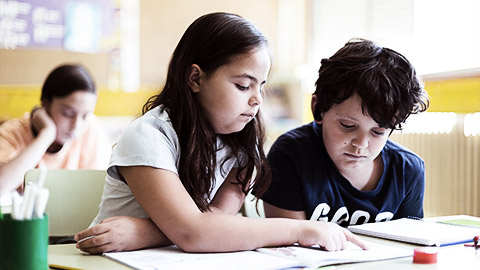
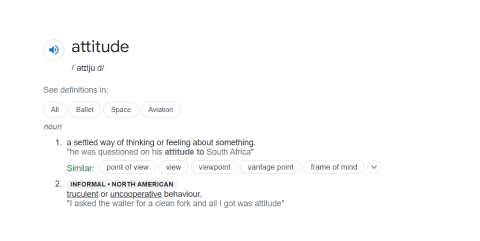
Attitudes are ways of thinking that influence our behaviour.
They begin to form in childhood and are influenced by both family and culture. They can be difficult to change. Beliefs are things that we accept as true- but they may not always be based on fact. For example, racism or sexism. They can be difficult to change. Each person has a unique belief system based on values, attitudes and traditions that has been shaped by family, culture, society and life experiences.
Educators can explore their personal attitudes, values, and beliefs by asking a series of questions to promote critical self-reflection. For example, consider how you might respond to the following questions above. Reflecting on such questions encourages educators to look inwards and reflect on how their personal attitudes, values and beliefs shape their practice.
Cultural Competence
Cultural Competence means being aware of your own cultural beliefs and values and how these may be different from other cultures, including being able to learn about and honor the different cultures of those who you work with and the families that are a part of an education and care service.
What would this look like?
Cultural competence is a key practice in the learning frameworks, and the notion of cultural competence is embedded throughout. For example, principles within the learning frameworks relevant to cultural competence include fostering secure, respectful and reciprocal relationships, partnerships, high expectations and equity and respect for diversity.
Issues of respecting and valuing diversity and culture are embedded in the Being, Belonging, Becoming themes of the Early Years Learning Framework. This framework acknowledges there are many ways of living, being and of knowing. Children are born belonging to a culture, which is not only influenced by traditional practices, heritage and ancestral knowledge, but also by the experiences, values and beliefs of individual families and communities. Respecting diversity means, within the curriculum, valuing and reflecting the practices, values and beliefs of families.
There are links to cultural competence in Learning Outcome 2 – Children are connected with and contribute to their world, including:
- children develop a sense of belonging to groups and communities and an understanding of the reciprocal rights and responsibilities necessary for active community participation
- children respond to diversity with respect
- children become aware of fairness
- children become socially responsible and show respect for the environment.
It is also important to remember that a guiding principle of the Education and Care Services National Law is that Australia’s Aboriginal and Torres Strait Islander cultures are valued.
What it looks like in practice in an Early Childhood Education and Care Environment
Educators who are culturally competent respect multiple cultural ways of knowing, seeing and living, celebrate the benefits of diversity and have an ability to understand and honour differences. Educators also seek to promote children’s cultural competence.
In practical terms, it is a never ending journey involving critical reflection, of learning to understand how people perceive the world and participating in different systems of shared knowledge.
Cultural competence is not static, and our level of cultural competence changes in response to new situations, experiences and relationships. The three elements of cultural competence are:
- attitudes
- skills
- knowledge
These are important at three levels:
- individual level – the knowledge, skills, values, attitudes and behaviours of individuals
- service level – management and operational frameworks and practices, expectations, including policies, procedures, vision statements and the voices of children, families and community
- the broader system level – how services relate to and respect the rest of the community, agencies, Elders, local community protocols.
While there is no checklist to tick off to identify culturally competent educators, we can start to build a picture of the attitudes, skills and knowledge required. For example, educators who respect diversity and are culturally competent:
- have an understanding of, and honour, the histories, cultures, languages, traditions, child rearing practices
- value children’s different capacities and abilities
- respect differences in families’ home lives
- recognise that diversity contributes to the richness of our society and provides a valid evidence base about ways of knowing
- demonstrate an ongoing commitment to developing their own cultural competence in a two-way process with families and communities
- promote greater understanding of Aboriginal and Torres Strait Islander ways of knowing and being
- teach, role-model and encourage cultural competence in children, recognising that this is crucial to ensuring children have a sense of strong cultural identity and belonging
- engage in ongoing reflection relating to their cultural competence and how they build children’s cultural competence.
When looking at embedding Cultural Competence into daily practice for yourself and the team around you take these 3 steps into consideration:
- Self-awareness
- Striving to understand how your background has shaped beliefs, values, and attitudes
- Challenging your own assumptions
- Realising that everyone has biases
- Seeking to understand
- Learning about others’ cultural and sociocultural perspectives
- Recognising that cultures differ
- Learning about cultural values, beliefs, and behaviours
- Put what was learned into practice
- Honouring other cultures in daily practice
- Casting yourself in the role of the learner
- Realising that curriculum is not neutral
The Victorian Early Years Learning and Development Framework (VEYLDF) incorporates indigenous elements further stating that, ‘learning about and valuing the place of Aboriginal people will enhance all Victorian children’s sense of place in our community’.
Case Study

Manisha is a 4 year old child who's family has migrated to Australia from Delhi. Manish's family has no local releitives and English is limited.
When Manisha commences at the serivce, the staff have greeted her and her family in their native language. In the room there is labels around with different words in Hindi and their meaning in English. This is to help the parents, educators and Manisha communicate with each other.
As well the staff in Manisha's room have incorporated some Hindi celebrations into their cultural events calendar to use as learning opportunities for the children in the room to connect with Manisha.
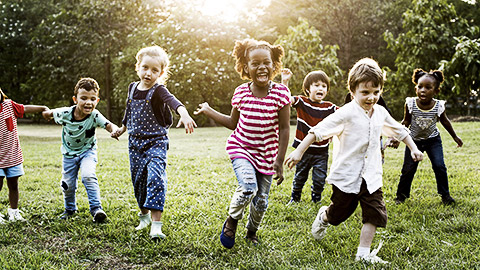
The National Quality Standards inform educators to incorporate diversity and inclusion within all practices by using child-centred approaches that demonstrate cultural competency and safety for all children and their families. Here the focus should be on building the strengths of identity, connections to community and culture throughout decision making, critical reflection and foundations of the program.
Educators build equitable, respectful and responsive relationships with children and families, supporting them to feel secure, safe and develop a sense of belonging within the service. The dignity and rights of the child and family are maintained at all times through all aspects of the service and curriculum.
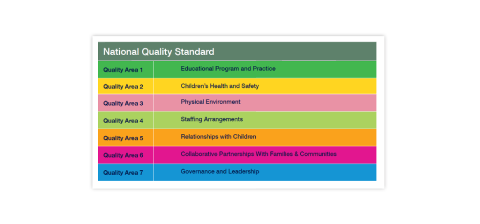
- Education and Care Services National Regulations inform that interactions with children must:
- Encourage the children to express themselves and their opinions
- Allow the children to undertake experiences that develop self-reliance and self-esteem
- Maintain at all times the dignity and rights of each child
- Give each child positive guidance and encouragement toward acceptable behaviour
- Have regard to the family and cultural values, sexual identification, age, and physical and intellectual development and abilities of each child being educated and cared for by the service
Service providers, including schools:
- Early learning service providers and their managers shape the service culture and operations. Their leadership, planning decisions, programming, participation, environmental design and their commitment to partnerships and professional development, all influence the extent and effectiveness of inclusive practice.
Leadership and planning:
- Boards set inclusion as a strategic priority for their organisation.
- Boards and executives commit to an inclusive culture and understand inclusion as fundamental to effective service delivery.
- Managers prioritise an orientation to inclusive culture and practice when recruiting, retaining, promoting, and providing professional development to staff.
- Services are based on, and responsive to, relevant laws, regulations, standards, and good practice guidelines.
- Organisations adopt service support planning as a vehicle to identify barriers to inclusion and support collaborative approaches, working with families and across professions to plan services for individuals.
Inclusion, Equity Policy and Procedure
A service's policies and procedures should outline the expectations of the service so that it is inclusive of all families and staff. The service should aim to develop understanding and accepting relationships with families, encouraging a sense of belonging and cultural safety. This should extend to the relationships between staff.
Below are some examples of the regulations that relate to services policies and procedures.
168 Education and care service must have policies and procedures
- The approved provider of an education and care service must ensure that the service has in place policies and procedures in relation to the matters set out in subregulation (2).
Penalty: $1000.
Note—
These may include policies and procedures prepared by the approved provider in accordance with an education law of the participating jurisdiction. - Policies and procedures are required in relation to the following—
- health and safety, including matters relating to—
- nutrition, food and beverages, dietary requirements; and
- sun protection; and
- water safety, including safety during any water-based activities; and
- the administration of first aid; and
- sleep and rest for children;
- incident, injury, trauma and illness procedures complying with regulation 85;
- dealing with infectious diseases, including procedures complying with regulation 88;
- dealing with medical conditions in children, including the matters set out in regulation 90;
- emergency and evacuation, including the matters set out in regulation 97;
- delivery of children to, and collection of children from, education and care service premises, including procedures complying with regulation 99;
- excursions, including procedures complying with regulations 100 to 102;
- if the service transports or arranges transportation of children other than as part of excursions, transportation including procedures complying with Division 7 of Part 4.2 of Chapter 4;
- providing a child safe environment;
- staffing, including—
- a code of conduct for staff members; and
- determining the responsible person present at the service; and
- the participation of volunteers and students on practicum placements;
- staffing, including—
- interactions with children, including the matters set out in regulations 155 and 156;
- enrolment and orientation;
- governance and management of the service, including confidentiality of records;
- the acceptance and refusal of authorisations;
- payment of fees and provision of a statement of fees charged by the education and care service;
- dealing with complaints.
- health and safety, including matters relating to—
170 Policies and procedures to be followed
- The approved provider of a centre-based service must take reasonable steps to ensure that nominated supervisors and staff members of, and volunteers at, the service follow the policies and procedures required under regulation 168. Penalty: $1000.
- The approved provider of a family day care service must take reasonable steps to ensure that nominated supervisors and staff members of, and family day care educators engaged by or registered with, the service follow the policies and procedures required under regulations 168 and 169.
Penalty: $1000.
Check out the Little.ly Early Learning Centre Inclusion and Diversity Policy to provide you with an example of a service's policy and procedure and how a service may design them and the content they include.
The Code of Ethics
The Code of Ethics sets aside guidelines for those working with children and families in early childhood education settings, recognising that 'Aboriginal and Torres Strait Islander people have been nurturing and teaching children on this land for thousands of years... [and the] traditional ways of being and caring for children' (Early Childhood Australia (ECA) 2019). The Code of Ethics is a framework for professional reflection, decision making and ethical responsibilities based on principles in the United Nations Convention on the Rights of the Child (1991) and the Declaration on the Rights of Indigenous Peoples (2007).
The key principles based on fundamental values of the profession include (Early Childhood Australia (ECA) 2019):
Each child has unique interests and strengths and the capacity to contribute to their communities
- Children are citizens from birth with civil, cultural, linguistic, social and economic rights
- Effective learning and teaching is characterised by professional decisions that draw on specialised knowledge and multiple perspectives
- Partnerships with families and communities support shared responsibility for children's learning, development and wellbeing
- Democratic, fair and inclusive practices promote equity and a strong sense of belonging
- Respectful, responsive and reciprocal relationships are central to children's education and care
- Play and leisure are essential for children's learning, development and wellbeing
- Research, inquiry and practice-based evidence inform quality education and care
United Nations Convention on the Rights of the Child
The United Nations created the human rights treaty for children over 30 years ago which developed an international agreement on the rights of childhood, helping to transform the lives of children around the world.
The Declaration on the rights of the Indigenous peoples is the most comprehensive international instrument on the rights of indigenous peoples and took years to reach a unanimous vote of agreeance.
To view the entire UN Convention on the Rights of a Child view the document here.
THE UNITED NATIONS STATE THAT 'IT ESTABLISHES A UNIVERSAL FRAMEWORK OF MINIMUM STANDARDS FOR THE SURVIVAL, DIGNITY AND WELLBEING OF THE INDIGENOUS PEOPLES OF THE WORLD AND IT ELABORATES ON EXISTING HUMAN RIGHTS STANDARDS AND FUNDAMENTAL FREEDOMS AS THEY APPLY TO THE SPECIFIC SITUATION OF INDIGENOUS PEOPLES.(UNITED NATIONS, 2007)
Resource
Check out the Cultural Connections Booklet by Child Professional Support. This resource was created to help services engage in key topics around ‘respect and diversity’ and ‘cultural competency’ in the early childhood education and care sector. The resource comprises of 3 parts self, relationship and environment and resources.
Click here to check out the resource.
United Nations Declaration on the Rights of Indigenous People’s
As we have spoken in modules previously that there is the UN Convention on the Rights of a Child, but did you know there was a version created specifically for Indigenous people?
Guided by the purposes and principles of the Charter of the United Nations, and good faith in the fulfilment of the obligations assumed by States in accordance with the Charter, Affirming that indigenous peoples are equal to all other peoples, while recognizing the right of all peoples to be different, to consider themselves different, and to be respected as such, Affirming also that all peoples contribute to the diversity and richness of civilizations and cultures, which constitute the common heritage of humankind.
The document comprises of 46 Articles. To review this document.
- Respect for diversity and working for equity is highlighted in the Australian Early Years Learning Framework (EYLF) and the My Time, Our Place as key principles underpinning early and middle childhood educational practice. Both learning frameworks note that ‘respecting diversity means within the curriculum valuing and reflecting the practices, values and beliefs of families’. The frameworks also state that educators ‘who are committed to equity believe in all children’s capacities to succeed, regardless of diverse circumstances and abilities
- The guiding principle of inclusion in early childhood education and care (ECEC) services is that all children, regardless of their ability, socio- economic status or cultural background, may access and participate in the service in the same way as other children.
- The fundamental principles are: integrity, objectivity, professional competence and due care, confidentiality, and professional behaviour.
- Quality Area 1: Educational program and practice
- Quality Area 5: Relationships with Children
- Quality Area 6: Collaborative Partnerships with Families and Communities
